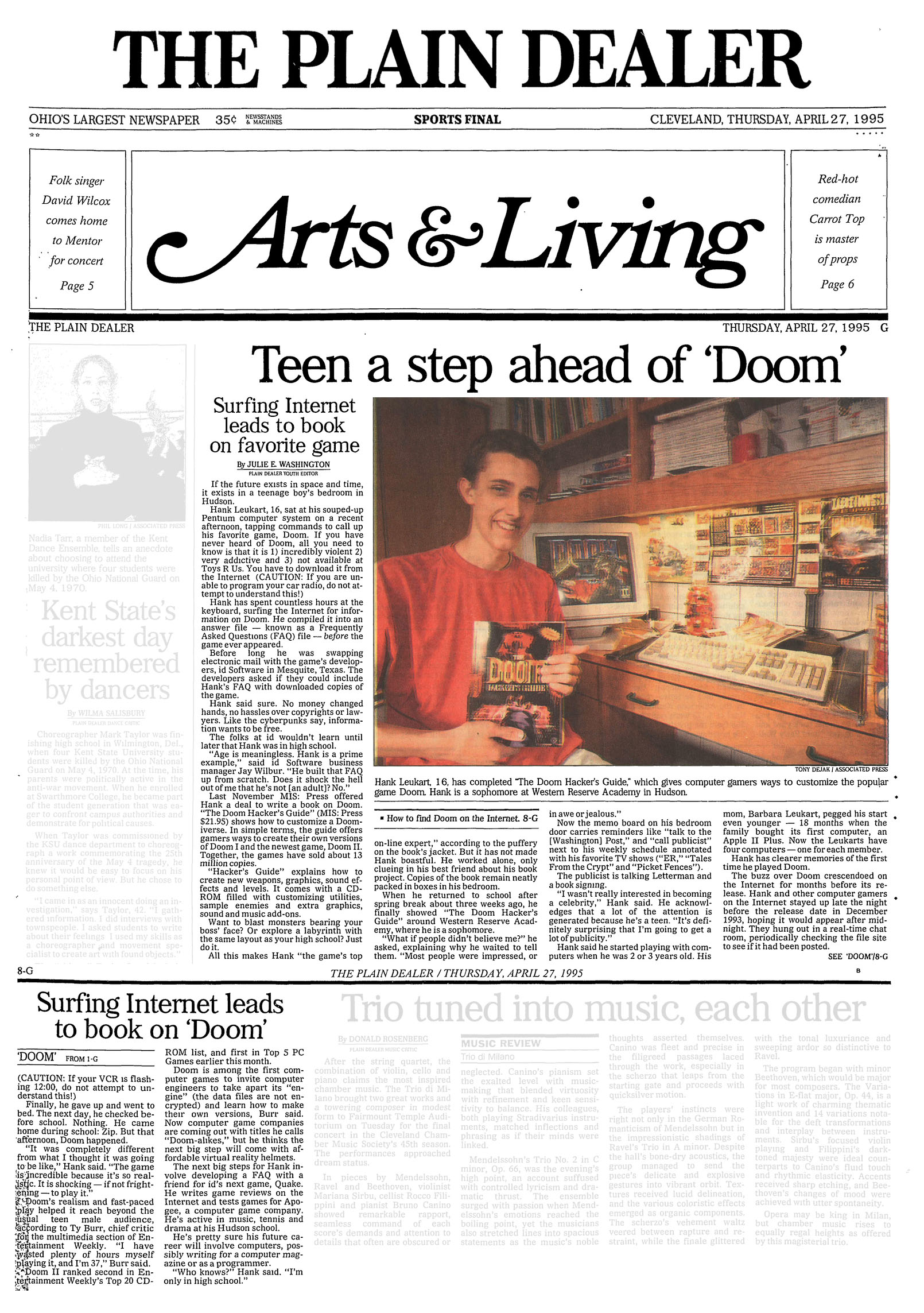Teen a step ahead of ‘Doom’
SURFING INTERNET LEADS TO BOOK ON FAVORITE GAME

By Julie E. Washington, from The Plain Dealer, April 27, 1995
If the future exists in space and time, it exists in a teenage boy’s bedroom in Hudson. Hank Leukart, 16, sat at his souped-up Pentium computer system on a recent afternoon, tapping commands to call up his favorite game, Doom. If you have never heard of Doom, all you need to know is that it is 1) incredibly violent 2) very addictive and 3) not available at Toys R Us. You have to download it from the Internet. (CAUTION: If you are unable to program your car radio, do not attempt to understand this!)
Hank has spent countless hours at the keyboard, surfing the Internet for information on Doom. He compiled it into an answer file – known as a Frequently Asked Questions (FAQ) file – before the game ever appeared.
Before long he was swapping electronic mail with the game’s developers, id Software in Mesquite, Texas. The developers asked if they could include Hank’s FAQ with downloaded copies of the game.
Hank said sure. No money changed hands, no hassles over copyrights or lawyers. Like the cyberpunks say, information wants to be free.
The folks at id wouldn’t learn until later that Hank was in high school.
“Age is meaningless. Hank is a prime example,” said id Software business manager Jay Wilbur. “He built that FAQ up from scratch. Does it shock the hell out of me that he’s not [an adult]? No.”
Last November MIS: Press offered Hank a deal to write a book on Doom. “The Doom Hacker’s Guide” (MIS: Press $21.95) shows how to customize a Doom-iverse. In simple terms, the guide offers gamers ways to create their own versions of Doom I and the newest game, Doom II. Together, the games have sold about 13 million copies.
“Hacker’s Guide” explains how to create new weapons, graphics, sound effects and levels. It comes with a CD-ROM filled with customizing utilities, sample enemies and extra graphics, sound and music add-ons.
Want to blast monsters bearing your boss’ face? Or explore a labyrinth with the same layout as your high school? Just do it.
All this makes Hank “the game’s top on-line expert,” according to the puffery on the book’s jacket. But it has not made Hank boastful. He worked alone, only clueing in his best friend about his book project. Copies of the book remain neatly packed in boxes in his bedroom.
When he returned to school after spring break about three weeks ago, he finally showed “The Doom Hacker’s Guide” around Western Reserve Academy, where he is a sophomore.
“What if people didn’t believe me?” he asked, explaining why he waited to tell them. “Most people were impressed, or in awe or jealous.”
Now the memo board on his bedroom door carries reminders like “talk to the [Washington] Post,” and “call publicist” next to his weekly schedule annotated with his favorite TV shows (“ER,” “Tales From the Crypt” and “Picket Fences”).
The publicist is talking Letterman and a book signing.
“I wasn’t really interested in becoming a celebrity,” Hank said. He acknowledges that a lot of the attention is generated because he’s a teen. “It’s definitely surprising that I’m going to get a lot of publicity.”
Hank said he started playing with computers when he was 2 or 3 years old. His mom, Barbara Leukart, pegged his start even younger – 18 months when the family bought its first computer, an Apple II Plus. Now the Leukarts have four computers – one for each member.
Hank has clearer memories of the first time he played Doom.
The buzz over Doom crescendoed on the Internet for months before its release. Hank and other computer gamers on the Internet stayed up late the night before the release date in December 1993, hoping it would appear after midnight. They hung out in a real-time chat room, periodically checking the file site to see if it had been posted.
(CAUTION: If your VCR is flashing 12:00, do not attempt to understand this!)
Finally, he gave up and went to bed. The next day, he checked before school. Nothing. He came home during school: Zip. But that afternoon, Doom happened.”It was completely different from what I thought it was going to be like,” Hank said. “The game is incredible because it’s so realistic. It is shocking – if not frightening – to play it.”
‘Doom’s realism and fast-paced play helped it reach beyond the usual teen male audience, according to Ty Burr, chief critic for the multimedia section of Entertainment Weekly. “I have wasted plenty of hours myself playing it, and I’m 37,” Burr said.
Doom II ranked second in Entertainment Weekly’s Top 20 CD-ROM list, and first in Top 5 PC Games earlier this month.
Doom is among the first computer games to invite computer engineers to take apart its “engine” (the data files are not encrypted) and learn how to make their own versions, Burr said. Now computer game companies are coming out with titles he calls “Doom-alikes,” but he thinks the next big step will come with affordable virtual reality helmets.
The next big steps for Hank involve developing a FAQ with a friend for id’s next game, Quake. He writes game reviews on the Internet and tests games for Apogee, a computer game company. He’s active in music, tennis and drama at his Hudson school.
He’s pretty sure his future career will involve computers, possibly writing for a computer magazine or as a programmer.”Who knows?” Hank said. “I’m only in high school.”